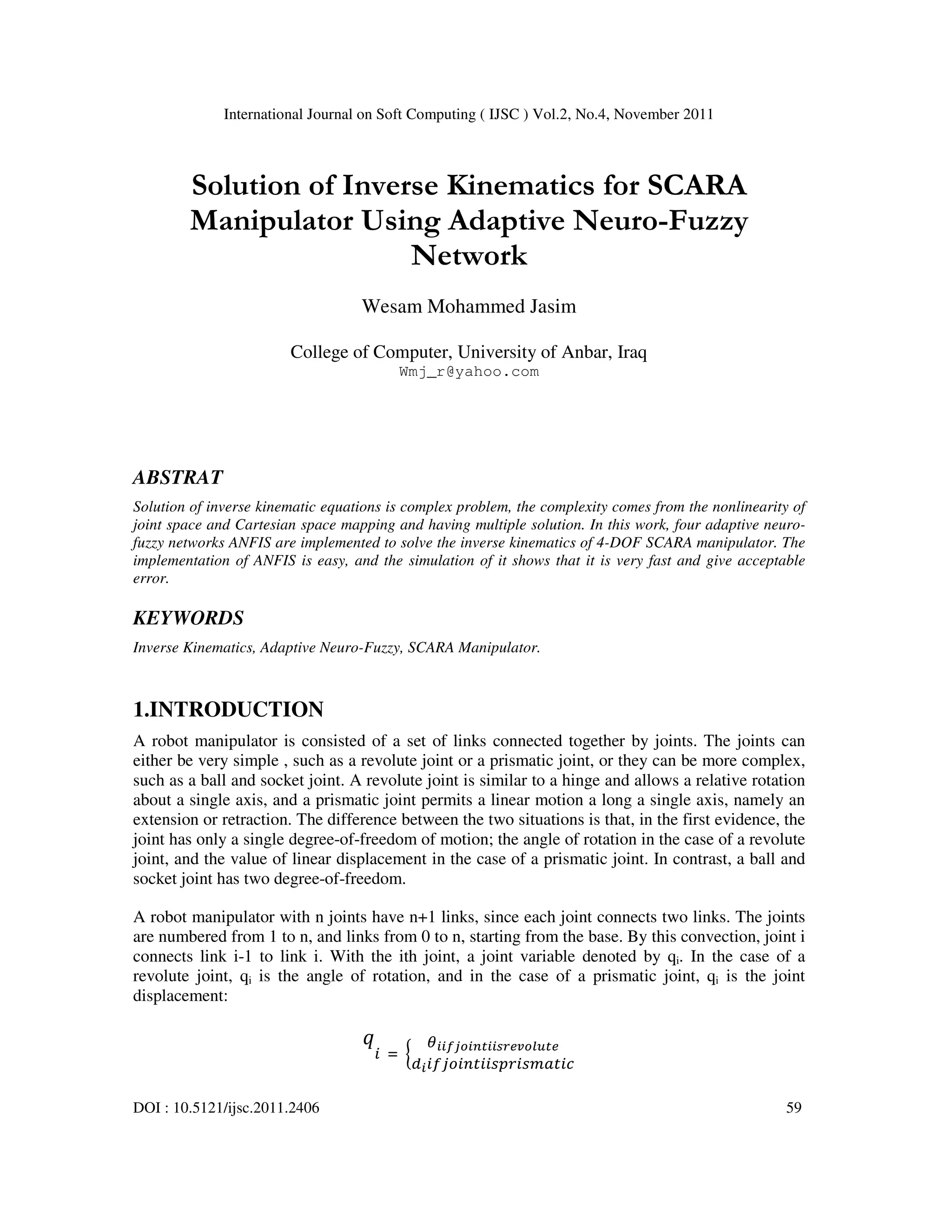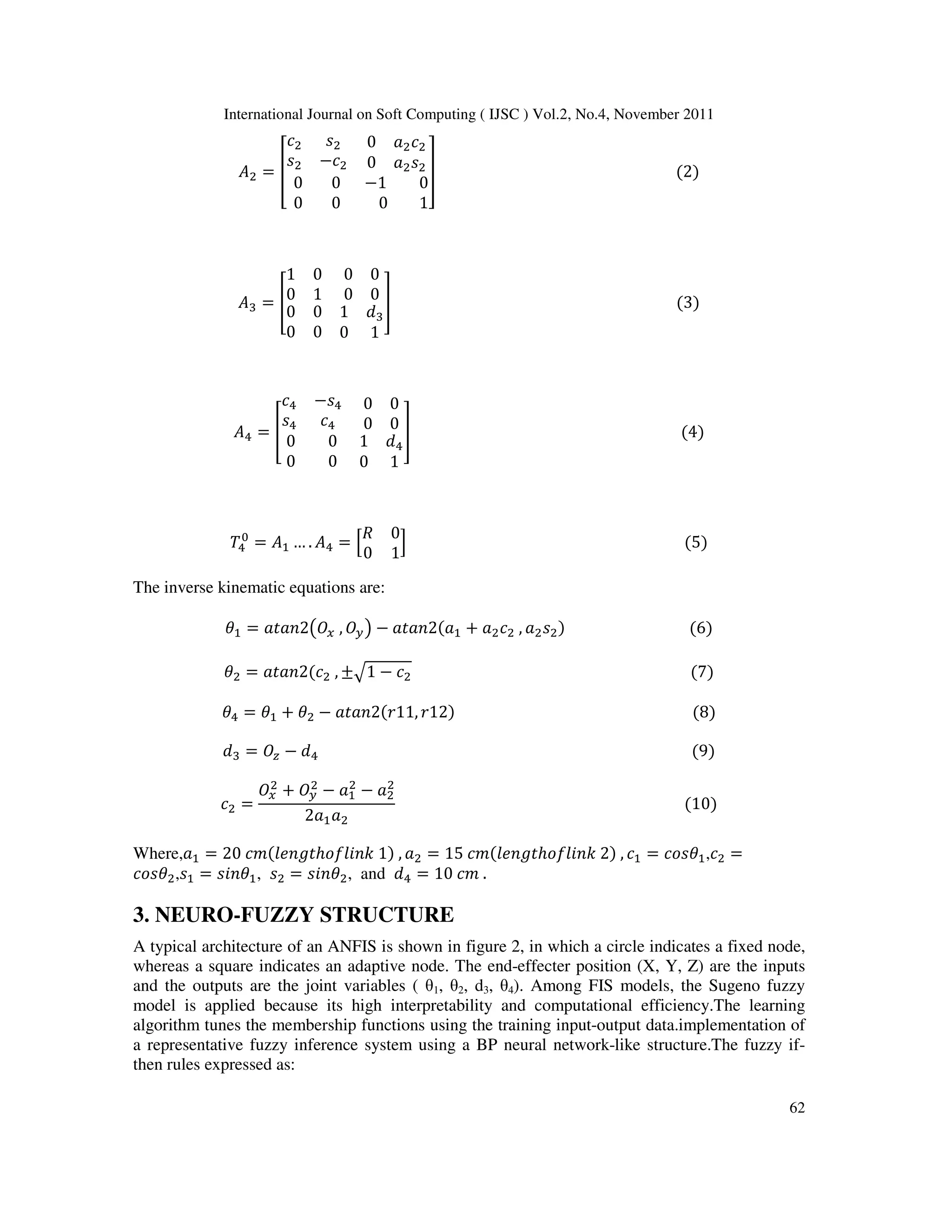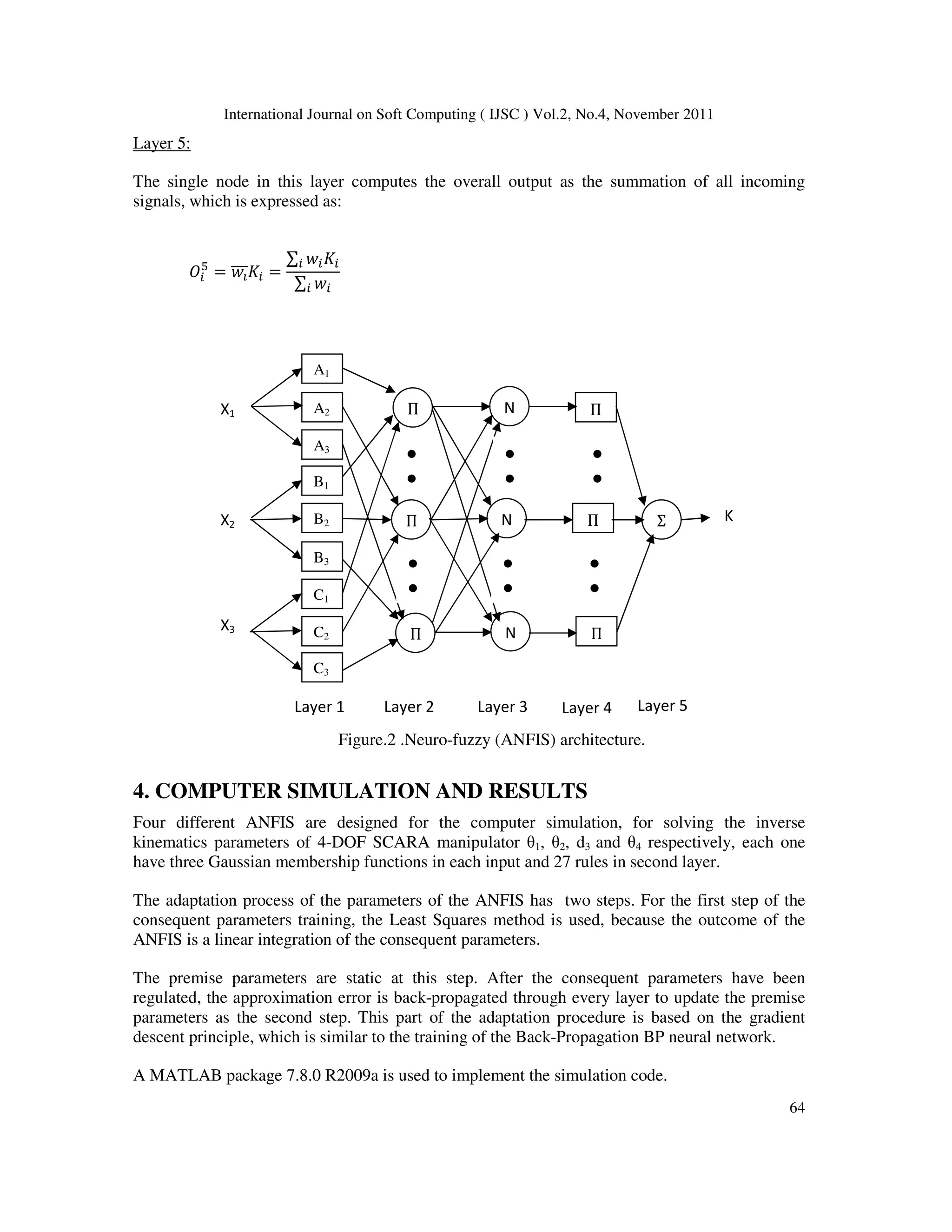This document discusses the solution of inverse kinematics for a SCARA manipulator using Adaptive Neuro-Fuzzy Inference Systems (ANFIS). It outlines the complexity of the inverse kinematic equations due to non-linearity and multiple solutions, presenting a method that efficiently approximates joint variables from desired positions. The results demonstrate the effectiveness of the ANFIS approach in achieving reliable and accurate solutions for the manipulator's kinematic parameters.

![International Journal on Soft Computing ( IJSC ) Vol.2, No.4, November 2011
60
The problem of kinematic is to demonstrate the motion of the manipulator without consideration
of the forces and torques causing the motion. There are two main kinematic problems. First one is
forward kinematic problem, which is to determine the position and orientation of the end effector
given the values for the joint variables of the robot. The second one is inverse kinematic problem
is to determine the amounts of the joint variables given the end effector’s position and orientation
[1]. At least 6 parameters are needed to describe the motion of the rigid body. Three parameters
are for position, three parameters are for orientation. Several methods are used in robot kinematic.
The most common method is Denavit and HartenbergDH notation for definition of special
mechanism. This method is based on point transformation approach and it is used 4 x 4
homogeneous transformation matrix which is introduced by Maxwell. Maxwell used
homogeneous coordinate systems to represent points and homogeneous transformation matrices
to represent the transformation of points. The coordinate systems are described with respect to
previous one. For the base point an arbitrary base coordinate system is used. Hence some
singularity problems may occur because of this coordinate systems description. And also in this
method 16 parameters are used to represent the transformation of rigid body while just 6
parameters are needed[2].
The inverse kinematics determines the joint variables that would result in a desired position of the
end-effector of the manipulator with respect to a reference coordinate system. The inverse
kinematics solution is difficult since the mapping between the joint space and Cartesian space is
non-linear and involves transcendental equations having multiple solutions. A unique solution
may be obtained in such cases if a performance criterion, like total joint displacement
minimization, is incorporated in the solution scheme[3].
There are several methods for solving Inverse Kinematics problems, YangshengXu, andMichael
C. Nechgba, discusses the automatic genexafion of the Fuzzy Inverse Kinematic Mapping
(FIKM) from specification of the DH parameters, the efficiency of the scheme in comparison to
conventional aPlYroaches, and the implementation results for both redundant and nonredundant
robots [4]. Ramakrishnan M. present a novel single-pass algorithm that is fast and eliminates
problems related with improper and large angle rotations [5]. E. Sariyildiz, and H. Temeltas,
present a formulation based on screw theory with dual-quaterninons for both forward and inverse
kinematic equations [2]. P. Kalra and etc. use real-coded genetic algorithms to obtain the inverse
kinematics solution of an articulated robotic manipulator [3].Samual R. Buss discuss the solution
of inverse kinematic with jacobian transpose, pseudoinverse and damped least squares methods
[7].Takehiko Ogawa and Hajime Kanada, propose a network inversion as a methodfor solving
inverse kinematics problem of a robot arm with multiple joints, where the joint angles are
conjectured from the givenend-effector coordinates [8]. Panchanand J., apply an artificial
neural network models to solve both the direct and indirect kinematics of robot
manipulator motion [9].
In this paper a Neuro-fuzzy structure is presented to solve the inverse kinematics of the SCARA (
Selective Compliant Articulated Robot for Assembly ) manipulator, which, as its name suggests,
is tailored for assembly operations.
2.SCARA MANIPULATOR
The SCARA manipulator has an (Revolute, Revolute, Prismatic) RRP structure, it is have a
kinematics of four degrees of freedom 4-DOF, the four degrees manipulator is different to others.](https://image.slidesharecdn.com/2411ijsc06-200828100210/75/Solution-of-Inverse-Kinematics-for-SCARA-Manipulator-Using-Adaptive-Neuro-Fuzzy-Network-2-2048.jpg)
![International Journal on Soft Computing ( IJSC ) Vol.2, No.4, November 2011
61
SCARA manipulator so different from the spherical manipulator in both appearance and in its
range of applications[6].
A 4-DOF SCARA manipulator has parallel shoulder, elbow, and wrist rotary joints, and a linear
vertical axis through the center of rotation of the wrist. This type of manipulator is very common
in light-duty applications such as electronic assembly, figure 1 shows the shape of SCARA
manipulator and its framework, and the DH joint parameters are given in Table (1) [1].
And the A-matrices are as follows.
ܣଵ = ൦
ܿଵ −ݏଵ
ݏଵ ܿଵ
0 ܽଵܿଵ
0 ܽଵݏଵ
0 0
0 0
1 0
0 1
൪ (1)
Link ai αi di θi
1
2
3
4
a1
a2
0
0
0
180
0
0
0
0
d*
d4
θ*
θ*
0
θ*
Table 1. DH Joint parameters for SCARA
Figure 1. DH coordinate frame assignment forthe SCARA manipulator.](https://image.slidesharecdn.com/2411ijsc06-200828100210/75/Solution-of-Inverse-Kinematics-for-SCARA-Manipulator-Using-Adaptive-Neuro-Fuzzy-Network-3-2048.jpg)

![International Journal on Soft Computing ( IJSC ) Vol.2, No.4, November 2011
63
If x is A and y is B and z is C then K= px + qy + sz + r
Where A, B and C are the fuzzy sets in the antecedent, and p, q, s and r are the design parameters
that are determined during the training process.
As in figure 2, the ANFIS comprises of five layers.The role of each layer is briefly presented as
follows:
letܱ
denote the output of node i in layer l, and xi is the ith input of the ANFIS,
i = 1;2;…..; p [10].
Layer1:
Every node i in employ a node function R given by:
ܱ
ଵ
= ܴ(ݔ)
Where ܴ can adopt any fuzzy membership function (MF).
Layer 2:
Every node calculates the firing strength of a rule via multiplication:
ܱ
ଶ
= ݓ = min (ܴ)
Where ݓ represent the activation level of a rule.
Layer 3:
Fixed node i in this layer calculate the ratio of the i-th rules activation level to the total of
all activation level:
ܱ
ଷ
= ݓపതതത =
ݓ
∑ ݓ
Where ݓపതതത is referred to as the normalized firing strengths.
Layer 4:
Every node i has the following function:
ܱ
ସ
= ݓపതതതܭ = ݓపതതത(ݔ + ݍݕ + ݏݖ + ݎ)
Where ݓపതതത is the output of layer 3, and ( pi ,qi,si,ri ) is the parameter set. The parameters in
this layer are referred to as the consequence parameters.](https://image.slidesharecdn.com/2411ijsc06-200828100210/75/Solution-of-Inverse-Kinematics-for-SCARA-Manipulator-Using-Adaptive-Neuro-Fuzzy-Network-5-2048.jpg)


![International Journal on Soft Computing ( IJSC ) Vol.2, No.4, November 2011
66
5. CONCLUSIONS
This work demonstrate that is possible to use Simulated ANFIS in order to present a very good
and reliable solution to the Inverse kinematics problem. The results of used ANFIS shows that it
have good and acceptable training error and small number of epoch in training all inverse
kinematic parameters of 4-DOF SCARA manipulator. At the same time, is important to say that
this technique is easy because its very simple to implement and calculating. Then use of ANFIS
give fast and acceptable solution of inverse kinematic parameters.
6. REFERENCES
[1] Mark W. Spong, Seth Hutchinson, and M. Vidyasagar, 2006, “ Robot Modeling and Control “ John
Wiley & Sons, New York.
[2] E. Sariyildiz, and H. Temeltas, 14-17 July, 2009, “ Solution of Inverse Kinematic Problem for Serial
Robot Using Dual Quaterninons and Plucker Coordinates “ IEEE/ASME, Singapore, pp.338-343.
[3] P. Kalra, P.B. Mahapatra, and D.K. Aggarwal, 2003, “ On the Solution of Multimodel Robot Inverse
Kinematic Functions using Real-coded Genetic Algorithms “ IEEE, pp. 1840-1845.
[4] YangshengXu and Michael C. Nechgba, 1993,“ Fuzzy Inverse Kinematic Mapping “ IROS
Conference.
[5] RamakrishnanMukundan, , 2008, “ A Fast Inverse Kinematics Solution for an n-link Joint Chain”
ICITA, pp. 349-354.
[6] Victor H. and etc., October 2010,“ Kinematics for the SCARA and the Cylindrical Manipulators “
ICIC, Vol. 4, No. 5, pp. 1-6.
[7] Samuel R. Buss, October, 2009, “ Introduction to inverse Kinematics with Jacobian Transpose,
Pseudoinverse and Damped Least Squares methods “ University of California press, pp. 1-19.
[8] Takehiko O. and H. Canada, 2010, “Solution for Ill-Posed Inverse Kinematics of Robot
ArmbyNetwork Inversion “ Hindawi Publishing Corporation, Journal of Robotics, Volume 2010,
doi:10.1155/2010/870923.
[9] Panchanand J., 2009, “Novel Artificial Neural Network Application for Prediction of Inverse
Kinematics of Manipulator” M.Sc. Thesis, National Institute of Technology, India.
[10] Dr. Bob John “Adaptive Network Based Fuzzy Inference Systems (ANFIS)
“.www.cse.dmu.ac.uk/~hseker/ANFISnotes.doc
Author
Wesam Mohammed Jasim is presently working as deputy dean in Computer
College, University of Anbar, Ramadi, Iraq, and completed B.Sc. and M.Sc.
in Electrical and Electronic Engineering/Control at 1996 and 2002
respectively, Al-Rasheed College for Engineering and Science, University of
Technology, Baghdad, Iraq.](https://image.slidesharecdn.com/2411ijsc06-200828100210/75/Solution-of-Inverse-Kinematics-for-SCARA-Manipulator-Using-Adaptive-Neuro-Fuzzy-Network-8-2048.jpg)